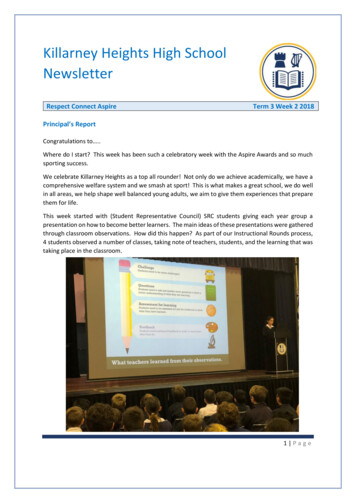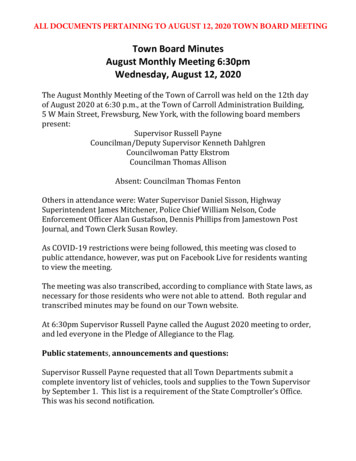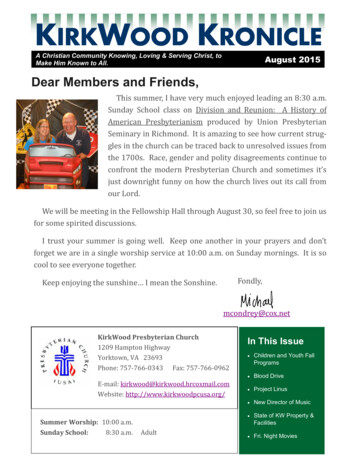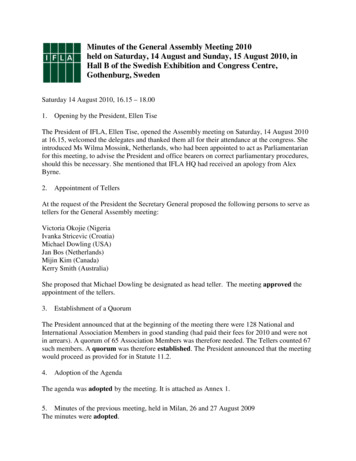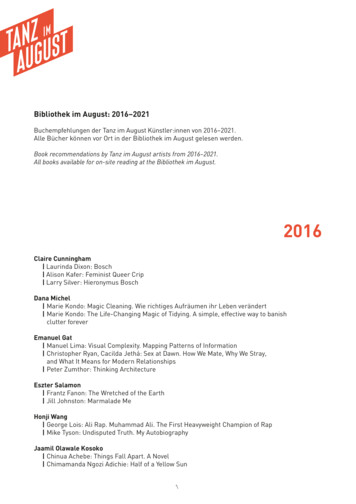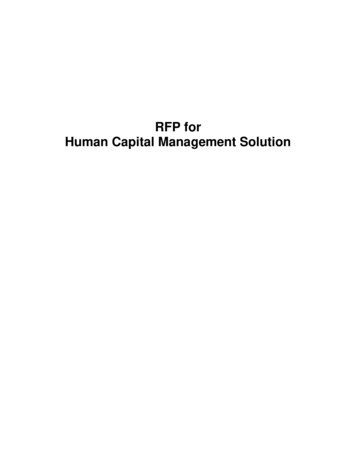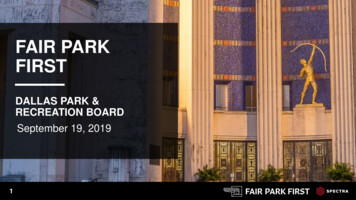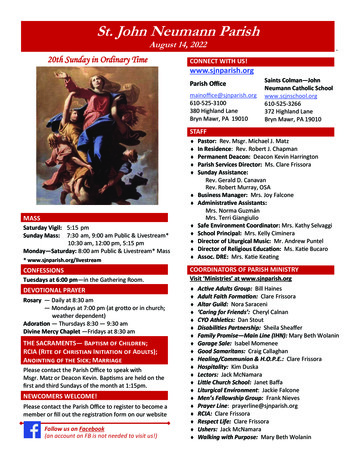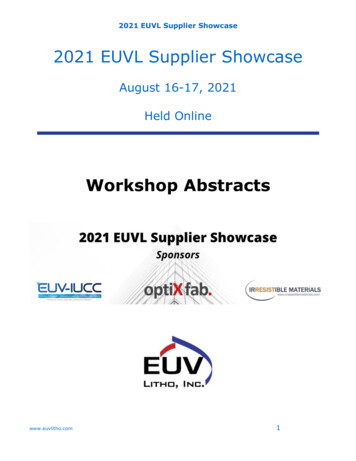
Transcription
2021 EUVL Supplier Showcase2021 EUVL Supplier ShowcaseAugust 16-17, 2021Held OnlineWorkshop Abstractswww.euvlitho.com1
2021 EUVL Supplier ShowcaseVivek Bakshi (EUV Litho, Inc.), ChairJinho Ahn (EUV-IUCC and Hanyang University), Co-Chairwww.euvlitho.com2
2021 EUVL Supplier ShowcaseContentsAbstracts by Paper Numberswww.euvlitho.com34
2021 EUVL Supplier ShowcaseAbstracts(Listed by Paper number)www.euvlitho.com4
2021 EUVL Supplier ShowcaseSS1Building a Success Company in EUVL Growth of Energetiq Technology, Inc.Debbie GustafsonWilmington, MA USAwww.energetiq.comEnergetiq Technology was founded in 2004 as a technology company developing 13.5nmEUV light sources. Energetiq realized early that it would be critical for the success of thestartup company to develop and sell product prior to EUV being in production. Energetiqintroduced a low power EUV metrology source in 2005. This source allowed criticalinfrastructure development of EUV Resist, Optics, Sensor and Mask inspection tools. Todate Energetiq has sold more than 40 EUV sources and as EUV has entered Semiconductorproduction the market is expanding. Debbie will share the success and struggles ofEnergetiq through the time from start up to present.Presenting AuthorDebbie Gustafson is the Chief Executive Officer of Energetiq Technology,Inc. and a member of its board of directors. Ms. Gustafson joined thecompany in 2005 as the VP of Sales, when the high technology start-upintroduced the first product. As CEO, Ms. Gustafson led the company intoa successful acquisition by Hamamatsu Corporation in 2017. She hascontinued in her role as CEO as a wholly owned subsidiary of HamamatsuCorporation and is driving the integration and growth strategy.Debbie has held strategic marketing and sales positions at Mykrolis(Entegris), ASTeX (MKS), Teradyne and Helix (Brooks Automation). Sheholds a BS in Mechanical Engineering from Southeastern MassachusettsUniversity (UMass Dartmouth) and an MBA in Management from BentleyUniversity. Currently Debbie is serving on the following boards; EnergetiqTechnology; University of Massachusetts, Dartmouth College ofEngineering Advisory Council; SEMI Foundation, SEMI North AmericanAdvisory Board; and SPIE Executive Advisory Council and NominatingCommittee.www.euvlitho.com5
2021 EUVL Supplier ShowcaseSS2Recent research activities in EUV-IUCC(Industry-University Collaboration Center)Jinho AhnEUV-IUCChttp://www.euv-iucc.org/EUV-IUCC (Industry-University Collaboration Center) is a non-profit organization supportedby industry members. EUV-IUCC was organized in September 2019 to help membercompanies to initiate their business in the field of EUV Lithography through providinginformation, education, networking and research collaboration. During the presentation, ourrecent research activities in the field of pellicle and mask in addition to the researchfacilities will be briefly introduced.Presenting AuthorJinho Ahn received his B.S. and M.S. degrees from Seoul NationalUniversity, and Ph.D. degree from the University of Texas at Austin all inMaterials Science and Engineering. He worked for MicroelectronicsResearch Laboratory at NEC, Tsukuba, Japan, and joined HanyangUniversity in 1995 as a professor of Materials Science and Engineering. Hehas been a leader of several national projects for advanced lithography.He has authored over 200 technical papers and invented more than 50patents. He worked as a Director of Nano and Convergence Technology atNational Research Foundation of Korea, the Vice President of AcademicResearch, and the President of Industry-University CooperationFoundation at Hanyang University. He is now a Member of the NationalAcademy of Engineering of Korea, and a board member of National NanoInfrastructure. He also works as a Director of EUV-IUCC since 2019. Hereceived the Semiconductor Technology Lifetime Achievement Award in2015 from the President of Koreawww.euvlitho.com6
2021 EUVL Supplier ShowcaseSS3Resist Technology for Single Digit Patterning: A solution forHigh-volume & High-throughput EUVLMohamad G. Moinuddin a, Satinder K. Sharma a,*, Kenneth E. Gonsalvesb,**Centre for Design & Fabrication of Electronic Devices, (C4DFED), SCEE a, SBS b,Indian Institute of Technology (IIT)-Mandi, MANDI-175075, (Himachal Pradesh),Indiawww.c4dfed.iitmandi.ac.in; http://www.photoresistgroup.comC4DFED@IIT Mandi, India is a unique class 100 cleanroom facility with sophisticated highend tools onsite to support multidisciplinary academic and industrial innovative researchand prototyping in electronics and EUV resist technology. However, expensive EUVexposure technology is still scarce and out of reach from the resist developers. Hence, theleading NGL pattering alternatives technologies: helium ion (He ) beam lithography (HIBL),electron beam lithography (EBL), along with imaging, deposition, etching, metrologytechniques including HR-FESEM, AFM, ALD, profilometry, contact lithography, masklesslithography, ellipsometer, stylus, sputtering, evaporation, etc. state-of-the-art facility hasbeen developed in-house to screening the developed NGL resists formulations prelude toEUVL high-volume chip manufacturing. What’s more, all relevant major resist formulationand materials characterization tools are available at the Photoresist Research Group facility(PRG) and Advanced Materials Research Center (AMRC) at IIT Mandi.EUVL is currently on the verge of high-volume production since the experimental load hasbeen distributed, and the cost/exposure has been reduced since 2018. The semiconductorroadmap suggests the primary concern is the downscaling of technology nodes, so theanswer lies in the availability of compatible resist technology. Here @C4DFED, weinvestigate the resist formulation reliability for single-digit ( 10 nm) pattern generationand continuous improvement in the key metric needed for EUV insertion to the HVM. Sincethe limited EUV source availability, we prelude to the analogs SOPs (protocols) based onreadily available patterning and metrology screening tools and proven that developedresists have high sensitivity, lower LER/LWR, high etch resistance for EUVL applications.[1]Beyond the general overview of the facility, we will focus on a few resist technologiesdeveloped in-house and subsequent competency of NGL pattering technologies down tosingle-digit, successfullydemonstrated accomplishments onto indigenously resistformulations for next-generation technology nodes.[1] All-new nickel-based Metal Core Organic Cluster (MCOC) resist for N7 node patterning; Satinder K. Sharma, et al., ","Proc. SPIE 11326, Advances in Patterning Materials and Processes XXXVII, 1132604 (2020)www.euvlitho.com7
2021 EUVL Supplier ShowcasePresenting AuthorSatinder K. Sharma [Ass.Prof.] (SMIEEE, SPIE, IETE-Fellow) received theMaster of Science in Physics (ES) from Himachal Pradesh University,Shimla, India, in 2002, and Ph.D. from Department of Electronic Science,Kurukshetra University, Kurukshetra, India, in 2007. From 2007 to 2010,he was a PDF at DST Unit on Nanosciences, CHE, IIT-Kanpur, India.From 2010 to 2012, he worked as a faculty with the Electronics andMicroelectronics Division, IIIT-Allahabad, India. Since 2012, he has beenworking as a faculty with the School of Computing and ElectricalEngineering, IIT-Mandi, India. 2015 he worked as Visiting Faculty,Institute of Semiconductor Electronics, Stuttgart University, Germany. Hepublished 95 plus publications in the international peer-review Journalsand 65 plus invited talksand research presentations ininternational/national conferences, also submitted six patents. His currentresearch interest includes; Nano/microelectronics technology, circuits andsystems, noble CMOS devices, nano/microfabrication,advancedlithography technology, sensors, and self-assembly, etc.www.euvlitho.com8
2021 EUVL Supplier ShowcaseSS4PAL-EUV synchrotron construction progress and EUVinfrastructure operation planSangsul LeePohang Accelerator Laboratory, POSTECHhttp://pal.postech.ac.krDue to the technical challenges in the EUV manufacturing process, technical advances inmaterials such as blank mask, pellicle and photo resist are needed.Securing EUV R&D infrastructure is also essential, EUV light and analytical infrastructurebased on synchrotron can help develop EUV materials.Construction of compact synchrotron and EUV R&D infrastructure dedicated to EUVLithography is underway at PAL campus to overcome the shortage of EUV researchinfrastructures.PAL is supporting basic research such as photoresist evaluation and is planning to supportoptical characteristics evaluation of blank mask, patterned mask and pellicle at the newEUV synchrotron in the near future.Through the showcase, we would like to share and discuss PAL's progress for EUVinfrastructure construction, which will be operated separately from early 2023 from theexisting synchrotron facilities.Presenting AuthorSangsul Lee is the head of the PAL-EUV metrology and inspection atPohang Accelerator Laboratory, POSTECH. He is also the chief technologyofficer of Xavisoptics, an X-ray solution and equipment company. Hereceived PhD in materials science and engineering from the HanyangUniversity in 2012. He currently runs X-ray nanoscale imaging beamlineand EUV test beamline at PAL. His research interest is synchrotron basednanoscale imaging such as EUV metrology, inspection and nanoscaletomography.www.euvlitho.com9
2021 EUVL Supplier ShowcaseSS5Preparing For The Next Generation of EUV Lithography at theCenter for X-ray OpticsRyan MiyakawaCXROhttp://cxro.lbl.govThe Center for X-ray Optics (CXRO) at Berkeley Lab has been a leader in EUV research forthe past 25 years. Leveraging 13.5-nm EUV light from the Advanced Light Sourcesynchrotron facility, CXRO is home to several EUV research tools that have providedimportant research insights into EUV resists, masks, and coatings. The 0.5-NA MET5 is aprojection lithography tool capable of printing feature sizes down to 8 nm half-pitch. A newradiation chemistry program is deploying several techniques aimed at dissecting the role ofprimary photo-electrons and secondary electrons in EUV resists. The SHARP microscopehas been outfitted with anamorphic zone plate lenses which can emulate the geometry ofnext generation EUV scanners. And the reflectometer is calibrated to measure bothmultilayer reflectivity as well as scattering profiles for the purpose of understanding the 3Deffects of EUV masks as well as determining mask properties. In parallel with these tools,the CXRO wavefront sensing program is developing high-resolution wavefront sensorssuitable for measuring aberrations at high NA. This paper presents an overview of theseprograms and describes how they will address the primary challenges that face the EUVcommunity as it moves to the next generation of EUV lithography.Presenting AuthorDr. Ryan Miyakawa is a research scientist at the Center for X-ray Optics atLBNL where he works on the Berkeley MET5 and the SHARP EUVmicroscope. Ryan’s interests include optical design for lithography andimaging, and high-NA wavefront sensing.www.euvlitho.com10
2021 EUVL Supplier ShowcaseSS6EUV Mask Technology: Ready for 5nm and beyondYusuke Suzuki, Yusuke SuzukiDai Nippon Printing Co., Ltd.https://www.dnp.co.jp/eng/index.htmlExtreme ultraviolet lithography (EUVL) is introducing for manufacturing of advancedsemiconductor devices in last year to re-accelerate “More Moore”.EUVL for 7nm logic node process has begun at the starting point and is expected to spreadto cutting-edge processes for 5nm node and beyond down to 2nm node or so.One of key technologies of EUVL is photomask manufacturing technologies that requireshigher resolution, more precise accuracy and better productivity. To get the solution, DNPhas installed a Multi-Beam Mask Writer (MBMW). The MBMW tool is equipped with 262thousand programmable beams, a 120-Gbps data-path, and an air-bearing stage, with subnm precision.With this system, DNP has developed the EUV mask process with the low-sensitivity andhigh-resolution resist for EUV lithography capable of 5nm node processes and beyond.MBMW also proves that its writing strategy is useful for patterning the very complexfeatures, such as the curvilinear patterns, with 1x nm resolution and reasonablethroughput. In this presentation, we will discuss MBMW and its process capability of EUVmask application, e.g. local CD uniformity, minimum resolution, image placement accuracy,curvilinear patterns and other applications.Presenting AuthorYusuke Suzuki is a sales manager at DNP, associate vice president atPDMC until 2019, and is currently in charge of DNP's EUV maskbusiness. He has realized the joint development of EUV masks withimec, and is leading DNP's collaboration with EUV related equipment andmaterial manufacturers.www.euvlitho.com11
2021 EUVL Supplier ShowcaseSS7Automated EUV tools for HVM – Pellicle Mounter/Demounter,Pellicle & Pod Inspection SystemsSung Won ChoiFINE SEMITECH CORP.(“FST”)www.fstc.co.krOver the few decades, technologies for semiconductor have advanced the integrationdensity in accordance with the Moore’s law. Also, massive improvements have been madefor device miniaturization. Current leading chipmakers already started to adopt ExtremeUltraviolet Lithography (EUVL) and have extended the use of EUV in their mass production.Supplementary innovations are required in tool automation and quality assurance for EUVLmass production. Fine Semitech Corp. (FST) has been developing EUV infrastructure tools:EPMD (EUV Pellicle Mounter & Demounter), EPIS (EUV Pellicle Inspection System) andEPODIS (EUV POD Inspection System). These systems are currently commercially availablefor customers. EUV Pellicle Mounter and Demounter (EPMD): FST developed a fully automated EUVPellicle Mounter and Demounter, the second generation of the Mask Shop Tool(MST). Main function of EPMD is to automatically mount and demount EUV pellicles. EUV Pellicle Inspection System (EPIS): EPIS was developed to inspect defects onEUV pellicle’s membrane and backside of the mask. These defects can seriouslyimpact production yield rates and performances of devices during EUV lithographyprocess. As a result, the importance of EUV pellicle is constantly increasing forchipmakers.EUV POD Inspection System (EPODIS): EPODIS was developed to inspect plating qualityand defects on EUV Dual Pods. The EUV Dual Pod consist of an inner pod and an outer pod.As the importance of the contamination control of EUV mask increases, the importance ofinspection on the EUV Dual Pod also increases.www.euvlitho.com12
2021 EUVL Supplier ShowcasePresenting AuthorJoined FST in 2020, Dr. Sungwon Choi is the chief technology officer(CTO) and a research director for EUV lithography automation technology.Sungwon Choi has had over 19 years of experience in semiconductor R&Dand mass production for lithography process development. He began hiscareer in advanced process development at Samsung Electronics in 2003.He was the leading member of the lithography mass production for 10 nmLSI device and also led 7 nm, 5 nm and 4 nm logic device development.He also received several R&D awards during his career in SamsungElectronics. Sungwon Choi holds a M.S. degree in Aero/Astronautics fromStanford University and a Ph.D. in Mechanical Engineering from UCLA.www.euvlitho.com13
2021 EUVL Supplier ShowcaseSS8EUV interference lithography and metrology at PSIIacopo MochiPaul Scherrer Institutehttps://www.psi.ch/en/lmnThe Laboratory for Micro and Nanotechnology at the Paul Scherrer institute is a Swissexcellence center for EUV research. It provides industrial and academic users with access tothe XIL-II beamline at the Swiss Light Source (SLS). The beamline is dedicated to EUVresearch for semiconductor manufacturing and is equipped with two end-stations thatexploit the coherence properties of the beam to investigate new materials and to performadvanced mask metrology without the necessity of complex and expensive EUV opticalsystems.The EUV-Interference Lithography end station is a state-of-the-art system used to printperiodic and semi-periodic nanostructures with a critical dimension of 8 nm. The EUV ILexposure tool is in operation since 2004 and it is successfully used for the screening anddevelopment of advanced EUV resist candidates for current and future technology nodes.The metrology end station is called RESCAN and it consists of a lensless EUV microscopededicated to actinic pattern mask inspection. Although RESCAN was developed as ademonstration tool, it can perform inspection of small mask samples and is fully compatiblewith EUV pellicles. RESCAN has been used to detect and characterize programmed phaseand amplitude defects as small as 50 nm on complex logic patterns and to characterize thetransmission and scattering of EUV pellicles as well as their impact on mask imaging.In this talk, we will present the status of the EUV research program at PSI and the availableservices and collaboration opportunities.Presenting AuthorDr. Iacopo Mochi started working on EUV mask inspection at LawrenceBerkeley Laboratory in the Center for X-Ray optics. He operated theSEMATECH AIT, an EUV microscope for mask review. He later worked onthe design and development of SHARP, an advanced EUV mask reviewtool that is currently operating at the Advanced Light Source in Berkeley.Subsequently, Dr. Mochi worked as an EUV mask R&D engineer at IMECon the topic of sub-resolution assist features. He is currently a staffscientist at the Swiss Light Source, and he is responsible for the technicaldevelopment of RESCAN, a lensless actinic system for mask defectinspection.www.euvlitho.com14
2021 EUVL Supplier ShowcaseSS9Synchrotron-radiation based EUV metrology at PTBMichael Kolbe, Victor Soltwisch, Frank ScholzePhysikalisch-Technische Bundesanstalt /abt7/fb-71/ag-712.htmlPTB is the German national metrology institute. It supports cooperation partners fromindustry and science with metrological capabilities and know-how within joint researchprojects. PTB uses synchrotron radiation in the THz, IR, UV, EUV, VUV, and soft X-rayspectral ranges at the electron storage rings Metrology Light Source (MLS) and BESSY IIfor basic and applied metrological tasks. For more than 20 years, the EUV-Radiometrygroup develops and provides metrology services for the characterization of opticalcomponents and radiation detectors as well as the measurement of optical materialproperties in the spectral range from 1 nm to 40 nm. It is worldwide recognized as a wellestablished partner for EUV metrology. PTB uses its synchrotron radiation laboratories alsofor lifetime investigations of optical components and radiation detectors. PTB offers servicesto determine the spectral responsivity of radiation detectors with traceability to a cryogenicradiometer as a primary detector standard in the full spectral range from UV to X-ray. TheEUV-Radiometry group uses two measurement stations at the storage rings BESSY II andMLS: an EUV reflectometer which can accommodate large optical components like collectormirrors for EUV plasma sources, and an EUV Ellipso-Scatterometer for reticle-size samplessupporting measurements of reflection and scattering under arbitrary polarizationconditions. The EUV nanometrology group develops methods for the actinic characterizationfor EUV optical components, e.g., the surface and interface roughness of multilayer mirrorscan be characterized by resonant diffuse EUV scattering. It also investigates methods forthe characterization of nanostructured surfaces, e.g., on wafer, by EUV and soft X-rayscattering and fluorescence.Presenting AuthorMichael Kolbe received his Ph.D. (focusing on X-ray based analysis) in2002. Since 2003 he is a scientist at PTB focusing on Metrology withsynchrotron radiation. His research activities include X-ray spectrometry,UV/VUV radiometry, and EUV radiometry. Based on these activities, heaccumulated expertise in employing analytical techniques in the UV to softX-ray spectral range. In 2020 he became head of PTB’s EUV radiometrygroup.www.euvlitho.com15
2021 EUVL Supplier ShowcaseSS10TNO, R&D service provider for theEUV Semiconductor IndustryNorbert KosterTNO, The try/roadmaps/semiconductorequipment/TNO is an independent research institute partly funded by Dutch and Europeangovernments to support the industry with innovation and new technologies. The majority ofthe projects for industrial applications are based on contract research and are companyconfidential. TNO has been and still is in close cooperation with ASML and Carl Zeiss sincethe beginning of the EUV development in 2000. Much of the knowledge developed by TNOis now being used for screening of materials and modules for EUV applications. TNOcontinues to invest in cooperation with the main players in EUV resulting in a strongbackground, knowledge, skills and facilities for the EUV community. TNO is capable ofperforming EUV exposures and contamination experiments to understand the damagemechanisms occurring in among others EUV optics, masks, pellicles and new absorbermaterials as well as realization of sensors and opto- mechatronic (sub)systems forequipment makers and realization of lab-tools. As independent organization TNO offers ahigh degree of reliability, flexibility, openness and transparency while respecting therequired secrecy of research results for individual customers.Presenting AuthorNorbert Koster is Principal Scientist at TNO in the group for Nanoinstrumentation, he has worked in vacuum technology and EUVlithography since 1992. After graduation he worked at the former FOMInstitute for Plasma Physics Rijnhuizen. There he was involved in thefabrication and optimization of Multilayer Mirrors for EUVL applications andspace astronomy as well as the improvement of the deposition tools. In1999 he started at TNO as vacuum engineer. Together with ASML andpartners he stood at the birthplace of the EUV Alfa demo tools and theirsuccessors. During his career he developed interest in vacuumengineering, systems engineering and contamination control. As PrincipalScientist he is involved in projects for EUV Lithography, plasmatechnology, contamination control, nuclear fusion (ITER).He was deeplyinvolved in the realization of a new EUV exposure facility (EBL2) for EUVoptics lifetime research at TNO in Delft.www.euvlitho.com16
2021 EUVL Supplier ShowcaseSS11Irradiation systems for accelerated testing of EUVL componentsJochen Vieker and Klaus BergmannFraunhofer Institute for Laser Technology – ILThttps://www.ilt.fraunhofer.de/en.htmlFraunhofer ILT has been developing EUV sources for more than 2 decades. In collaborationwith Philips and Ushio, ILT has contributed to the development of discharge based sources,which have been operated in the first EUV lithography scanners for chip production.Having the know-how on EUV sources and their implementation into optical system athand, ILT has been developing multitude of applications in collaboration with RWTH AachenUniversity, e.g., EUV laboratory-scale lithography for patterning and resist testing withdemonstrated resolution of 28 nm HP or EUV reflectometry for surface sensitive analysis.The talk will focus on the Fraunhofer high Irradiance Tool (FIT) for testing of opticalcomponents. It is based on our proven FS5440 high power EUV source, whose emission isfocused on a sample in controllable atmosphere. Using strong vacuum separation andparticle mitigation, an extremely low operating pressure at the irradiation position can beachieved without pumping orifices in the vicinity the focal spot. Thus, clean, unbiasedexperimental conditions can be achieved. The expected performance of the FIT includes:EUV irradiance 40 W/cm², angle of incidence on sample 5 , spot diameter 1.8 mm andpulse repetition rate up to 2.5 kHz. The design of the system allows multiplexing to reach10 kHz and a higher power on sample. An updated design and new results based on opticaland gas-flow simulations will be presented.Presenting AuthorJochen Vieker received his Diplom (M. Sc. equiv.) in physics in 2011 fromBielefeld University, for his work on high harmonic generation. Since thenhe has been scientist in the EUV technology group at the FraunhoferInstitute for Laser Technology and finished his PhD in physics in 2019 atRWTH Aachen University for his research on power and lifetime scaling ofdischarge based EUV sources. He is manager of the R&D projects andarchitect of ILT’s EUV systems. Fields of interest include fundamentalresearch on EUV sources and secondary sources based on laser radiationas well as their applications.www.euvlitho.com17
2021 EUVL Supplier ShowcaseSS12NIST at-wavelength EUVL metrologyC. Tarrio, R. E. Vest, R. F. BergNIST, Gaithersburg, MD, USAhttps://www.nist.gov/At the National Institute of Standards and Technology we have been involved in directsupport of the developers of EUV Lithography for over 30 years. Our program began withcharacterization of EUV detectors and other optical elements. In the last couple ofdecades, we have responded to the needs of the EUVL community by developing a morespecialized suite of capabilities including accurate reflectometry of large mirrors,contamination measurement and modeling, and out-of-band measurements. We willdescribe our capabilities and offer a few recent highlightsPresenting Authorwww.euvlitho.com18
2021 EUVL Supplier ShowcaseSS13AtOMS - Combined Atomic Absorption /Optical EmissionSpectroscopy for In-Situ Control of EUVL Thin FilmsGeorge AtanasoffAccuStrata, Inc.11900 Parklawn Drive, Rockville, MD 20852https://www.accustrata.com/The extremely thin metal-silicide and interface-engineered thin films, required for the EUVLand X-ray mirrors, fall below the detection threshold of the traditional in-situ methodsutilizing direct monitoring of the substrate. The in-situ control of deposition rate of opaquematerials as well as the chemical composition of compound materials and alloys alsoremain beyond the capability of the traditional in situ methods and require novelmonitoring solutions.AtOMS1 provides a practical solution for in situ deposition control of extremely thin films,compound thin films and complex multilayer structures with controlled interfaces as well asmetal alloys and opaque films. It combines the methods of element-specific atomicabsorption with the broadband optical emission (OE) measured in the plasma zonesurrounding the deposited/etched substrate and provides unique monitoring capability thatcannot be achieved by using any of these two techniques alone. It provides sensitive andaccurate values for the momentary element concentration of the films, their rate ofdeposition and process conditions. The deposition rates of up to 4 individual chemicalelements are monitored simultaneously and up to 3 separate probe beams can be launchedfor physical modeling of the film parameters and their uniformity over large wafers. Fiberoptics switching allows configurability and customization to fit any chamber geometry withlittle or without any retrofitting. The fiber optics components allow flexible installation withoptions for fast installation and demo outside the chamber through UV viewports, or insidethe deposition area for unprecedented sensitivity and accuracy. Physical modeling andmachine learning are used or modeling the deposition parameters2 such as deposition rateand composition and providing dynamic feedback control. Atomic concentration and deposition rates of 4 chemical elements simultaneously In situ control of interface and barriers layers with thickness 10Å In situ control of chemical composition of compound semiconductors and alloys Deposition rate accuracy - element specific (Mo 0.005Å/s, Si 0.01Å/s) Film composition accuracy 0.05 atomic % (element and process specific) Feedback control of individual vapor sources, process drift and fault detection Distributed monitoring over 300 mm wafers by 3 probe beams simultaneously Agnostic to substrate shape, position and motionwww.euvlitho.com19
2021 EUVL Supplier ShowcaseAtOMS dramatically reduces the process tuning time, facilitates process scale up, andlowers product cost. Specification as well as system installation and results from depositionof Mo, Si, B, W, and other thin films and multilayers are presented.1.2.G. Atanasoff, C. Metting and H.von Bredow, US patent 10,408,744, (2019);G. Atanasoff, US patent 8,918.198, (2014); EP 2,389,459 (2014);Presenting AuthorGeorge Atanasoff is a founder and president of AccuStrata, a technologyinnovator in the field of in situ process control for advanced manufacturingbased on distributed spectroscopic sensors and predictive analyticssoftware. Dr. Atanasoff is a well-recognized professional in the OpticalEngineering field with a career as university professor in Physics and over30-years of project and executive R&D management experience. In 2008he funded AccuStrata as part of the University of Maryland in College Parkand steered the company into a successful commercial venture. Georgehas over 60 scientific publications in this film design, process andmetrology, multiple patents and numerous scientific presentationsworldwide. Dr. Atanasoff has been a principal investigator of many federalprograms for developing process control systems for solar, solid-statelighting, EUVL and environmental application. He received his PhD inPhysics from University of Sofia in Bulgaria. George can be reached atgatanasoff@accustrata.comwww.euvlitho.com20
2021 EUVL Supplier ShowcaseSS15Multitrigger (MTR): An Irresistible PhotoresistWarren Montgomery1, Mark Shepherd1, David Ure1, Alex Robinson1, AlexandraMcClelland1, Carmen Popescu1 and Alan Brown1, Tom Lada2, John Roth2, EdJackson2, and Todd Smith31IrresistibleMaterials Ltd.Langdon House, Swansea Waterfront, Swansea SA1 8QY,United Kingdom
University (UMass Dartmouth) and an MBA in Management from Bentley University. Currently Debbie is serving on the following boards; Energetiq Technology; University of Massachusetts, Dartmouth College of Engineering Advisory Council; SEMI Foundation, SEMI North American Advisory Board; and SPIE Executive Advisory Council and Nominating .
